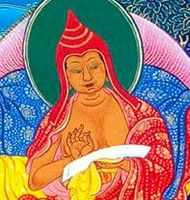Haribhadra: Difference between revisions
*>LauraG |
No edit summary |
||
| (12 intermediate revisions by 3 users not shown) | |||
| Line 1: | Line 1: | ||
{{Person | {{Person | ||
|HasDrlPage=Yes | |||
|HasLibPage=Yes | |||
|HasBnwPage=Yes | |||
|pagename=Haribhadra | |||
|PersonType=Classical Indian Authors | |||
|images=File:Haribhadra RigpaWiki.jpeg | |||
|MainNamePhon=Haribhadra | |||
|MainNameTib=སེངྒེ་བཟང་པོ་ | |||
|MainNameWylie=seng+ge bzang po | |||
|YearBirth=c. 800 | |||
|ReligiousAffiliation=Yogācāra-*Svātantrika | |||
|StudentOf=Vairocanabhadra | |||
|BdrcLink=https://www.tbrc.org/#!rid=P7297 | |||
|BnwShortPersonBio=Haribhadra. (T. Seng ge bzang po) (c. 800). Indian Buddhist exegete during the Pāla dynasty, whom later Tibetan doxographers associate with the Yogācāra-*Svātantrika syncretistic strand of Indian philosophy. He may have been a Student of Śāntarakṣita and was a contemporary of Kamalaśīla; he himself lists Vairocanabhadra as his teacher. Haribhadra is known for his two commentaries on the ''Aṣṭasāhasrikāprajñāpāramitāsūtra'' ("Prajñāpāramitā in Eight Thousand Lines"): the longer ''Abhisamayālaṃ kārālokā-Prajñāpãramitãvyãkhyã'', and its summary, the ''Abhisamayālaṃkāravivṛti''. He is also known for his recasting of the twenty-five-thousand-line version of the prajñāpāramitā (''Pañcaviṃśatisāhasrikāprajñāpāramitāsūtra'') in a work entitled the ''Le'u brgyad ma'' in Tibetan. Each of these works is based on the interpretative scheme set forth in the ''Abhisamayālaṃkāra'' ("Ornament for Clear Realizations"), a guide to the ''Pañcaviṃśati'' that Haribhadra explicitly attributes to Maitreya. His ''Abhisamayālaṃkārālokā'' builds upon Pramāṇa, Madhyamaka, and Abhidharma literature and was extremely influential in Tibet; its summary (known as "’grel pa don gsal" in Tibetan) is the root text (''rtsa ba'') for commentaries in the Gsang phu ne’u thog monastery tradition originating with Rngog Blo ldan shes rab. It is the most widely studied prajñāpāramitā commentary in Tibetan Buddhism to the present day. Haribhadra is known for his explanation of a ''jñānadharmakāya'' (knowledge truth-body) in addition to a ''svābhāvakāya'', viz., the eternally pure ''dharmadhātu'' that is free from duality. He is characterized as an alīkākāravādin ("false-aspectarian") to differentiate him from Kamalaśīla, a satyākāravãdin ("true- aspectarian") who holds that the objects appearing in the diverse forms of knowledge in a buddha's all-knowing mind are truly what they seem to be. He cites Dharmakīrti frequently but appears to accept that scripture (''āgama'') is also a valid authority (''pramāṇa''). There are two principal commentaries on his work, by Dharmamitra and Dharmakīrtiśrī. Buddhaśrījñāna (or simply Buddhajñāna) was his disciple. The ''Subodhinī'', a commentary on the ''Ratnaguṇasaṃcayagāthā'', is also attributed to him. (Source: "Haribhadra." In ''The Princeton Dictionary of Buddhism'', 345. Princeton University Press, 2014. http://www.jstor.org/stable/j.ctt46n41q.27.) | |||
|IsInGyatsa=No | |||
|classification=Person | |classification=Person | ||
}} | }} | ||
{{Footer}} | {{Footer}} | ||
<noinclude>{{DRL Authors of Sanskrit Works}} [[Category:Indian authors sanskrit names]]</noinclude> | <noinclude>{{DRL Authors of Sanskrit Works}} [[Category:Indian authors sanskrit names]]</noinclude> | ||
Revision as of 13:59, 4 March 2024
| PersonType | Category:Classical Indian Authors |
|---|---|
| MainNamePhon | Haribhadra |
| MainNameTib | སེངྒེ་བཟང་པོ་ |
| MainNameWylie | seng+ge bzang po |
| YearBirth | c. 800 |
| ReligiousAffiliation | Yogācāra-*Svātantrika |
| StudentOf | Vairocanabhadra |
| BDRC | https://www.tbrc.org/#!rid=P7297 |
| IsInGyatsa | No |
| BnwShortPersonBio | Haribhadra. (T. Seng ge bzang po) (c. 800). Indian Buddhist exegete during the Pāla dynasty, whom later Tibetan doxographers associate with the Yogācāra-*Svātantrika syncretistic strand of Indian philosophy. He may have been a Student of Śāntarakṣita and was a contemporary of Kamalaśīla; he himself lists Vairocanabhadra as his teacher. Haribhadra is known for his two commentaries on the Aṣṭasāhasrikāprajñāpāramitāsūtra ("Prajñāpāramitā in Eight Thousand Lines"): the longer Abhisamayālaṃ kārālokā-Prajñāpãramitãvyãkhyã, and its summary, the Abhisamayālaṃkāravivṛti. He is also known for his recasting of the twenty-five-thousand-line version of the prajñāpāramitā (Pañcaviṃśatisāhasrikāprajñāpāramitāsūtra) in a work entitled the Le'u brgyad ma in Tibetan. Each of these works is based on the interpretative scheme set forth in the Abhisamayālaṃkāra ("Ornament for Clear Realizations"), a guide to the Pañcaviṃśati that Haribhadra explicitly attributes to Maitreya. His Abhisamayālaṃkārālokā builds upon Pramāṇa, Madhyamaka, and Abhidharma literature and was extremely influential in Tibet; its summary (known as "’grel pa don gsal" in Tibetan) is the root text (rtsa ba) for commentaries in the Gsang phu ne’u thog monastery tradition originating with Rngog Blo ldan shes rab. It is the most widely studied prajñāpāramitā commentary in Tibetan Buddhism to the present day. Haribhadra is known for his explanation of a jñānadharmakāya (knowledge truth-body) in addition to a svābhāvakāya, viz., the eternally pure dharmadhātu that is free from duality. He is characterized as an alīkākāravādin ("false-aspectarian") to differentiate him from Kamalaśīla, a satyākāravãdin ("true- aspectarian") who holds that the objects appearing in the diverse forms of knowledge in a buddha's all-knowing mind are truly what they seem to be. He cites Dharmakīrti frequently but appears to accept that scripture (āgama) is also a valid authority (pramāṇa). There are two principal commentaries on his work, by Dharmamitra and Dharmakīrtiśrī. Buddhaśrījñāna (or simply Buddhajñāna) was his disciple. The Subodhinī, a commentary on the Ratnaguṇasaṃcayagāthā, is also attributed to him. (Source: "Haribhadra." In The Princeton Dictionary of Buddhism, 345. Princeton University Press, 2014. http://www.jstor.org/stable/j.ctt46n41q.27.) |
| Other wikis |
